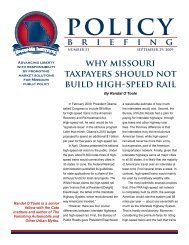MBTA Review - November 1, 2009
MBTA Review - November 1, 2009
MBTA Review - November 1, 2009
You also want an ePaper? Increase the reach of your titles
YUMPU automatically turns print PDFs into web optimized ePapers that Google loves.
<strong>Review</strong> Summary<br />
Backward<br />
Funding – Déjà Vu<br />
The net result of<br />
the Forward Funding<br />
experiment is that the<br />
<strong>MBTA</strong> has come full<br />
circle, with staggering<br />
debt, burgeoning deficits<br />
and “hat in hand.”<br />
The <strong>MBTA</strong> is again in<br />
Backward Funding mode.<br />
The transfer of $160M this summer to close the <strong>MBTA</strong>’s FY10 budget<br />
deficit marked a return to “backward funding.”<br />
In 2000, Forward Funding was intended to end chronic deficit spending<br />
by providing the <strong>MBTA</strong> with the tools, including dedicated revenues,<br />
to achieve self-sufficiency. A decade later, our analysis indicates that<br />
the promise of Forward Funding could not succeed as costs grew<br />
inexorably, revenues proved inadequate and the need to sustain capital<br />
investment outgrew the <strong>MBTA</strong>’s ability to “live within its means.” The<br />
Finance Plan that was devised to implement the goal of self-sufficiency<br />
was well intentioned, but founded upon a combination of optimistic,<br />
unrealistic and untested assumptions.<br />
Critics may argue that the <strong>MBTA</strong> did not “try hard enough” to embrace<br />
Forward Funding because it failed to control the growth of operating<br />
costs. These costs indeed grew by a cumulative half-billion dollars more<br />
than the Finance Plan had anticipated between FY01 and FY08, and<br />
their continuing growth defines the deepening structural deficits of the<br />
next five years.<br />
The Finance Plan substantially underestimated the system’s cost drivers,<br />
both for costs within the <strong>MBTA</strong>’s control, such as wages, but especially<br />
for costs outside its control, such as energy, health insurance and<br />
contracted services like commuter rail and The Ride.<br />
Contrary to not trying, we found evidence that the <strong>MBTA</strong> did make<br />
some hard expense choices. Across-the-board cuts were routinely<br />
made to departmental budgets. Periodic layoffs and hiring freezes<br />
restrained the headcount. Individual managers took pride in eliminating<br />
inefficiencies and redundancies, while embracing a new organizational<br />
ethic of customer service. Yet in the end, they could not pare staff<br />
below the number needed to move hundreds of thousands of riders<br />
across hundreds of routes each workday. Add the complexity and cost<br />
of sustaining the system’s aging infrastructure, and it became evident<br />
that the cost inflation and savings assumptions in the Finance Plan were<br />
never tested against the daily grind.<br />
Several studies have proposed that the debt the <strong>MBTA</strong> inherited from<br />
the State, and resulting debt service, are the primary reasons for the<br />
<strong>MBTA</strong>’s failure to thrive under Forward Funding. Yet as we learned,<br />
debt service payments were much lower than projected over the decade<br />
because it was frequently refinanced and restructured. If any decision<br />
by the <strong>MBTA</strong> is worth second-guessing, it was the repeated deferral<br />
of principal and interest payments into a future that now looks even<br />
harder to fix, given the growing structural deficit.<br />
<strong>MBTA</strong> <strong>Review</strong> | <strong>November</strong> <strong>2009</strong><br />
p. 29






